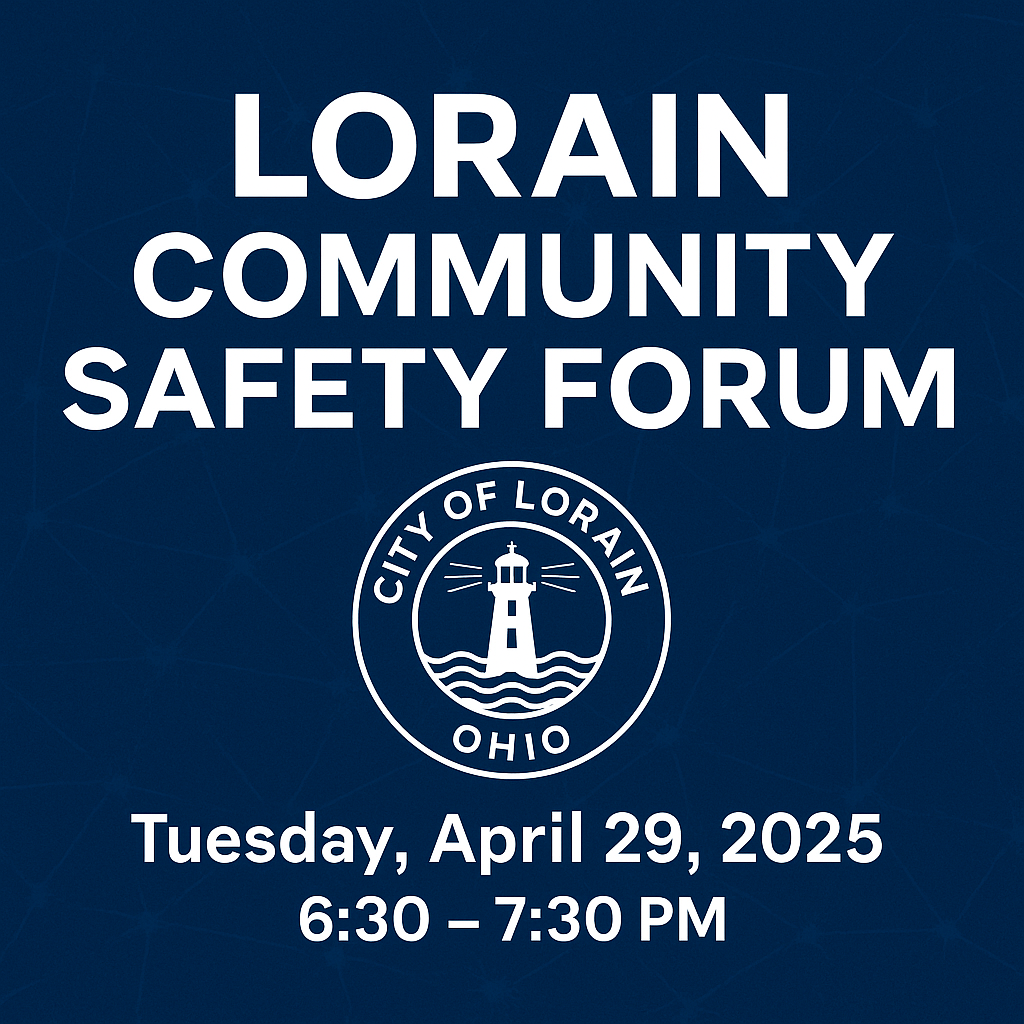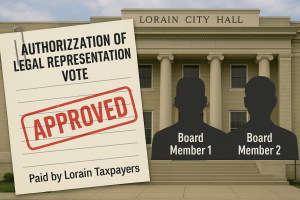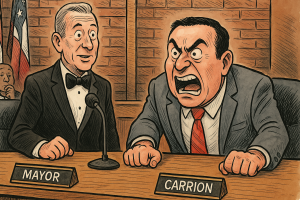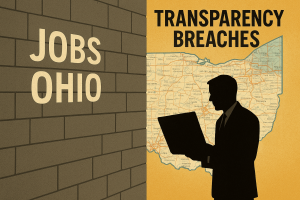A Town Hall for the Cameras: How Lorain’s Crime Meeting Gave Us Truth — and Theater

A Town Hall or a Campaign Rally? The Political Theater Behind Lorain’s Crime Meeting
Apr 30, 2025
Written by Aaron C. Knapp – Veteran, Licensed Social Worker (CDCA), Political Advocate, and Editor of Lorain Politics Unplugged. All views are my own and based on public record, firsthand participation, and confirmed facts.

“The Mayor said he wasn’t invited. He viewed this as a political event.”
— Councilman Tony Dimacchia
Introduction: A Full House, Half Representation
On the surface, Lorain’s April 2025 town hall on youth violence, crime, and public safety appeared to be a landmark event: a packed school auditorium, a diverse range of speakers, and a passionate public airing grievances and ideas. But for those paying close attention, the gathering also revealed serious political undertones and institutional gaps.
Thanks for reading Aaron’s Substack! Subscribe for free to receive new posts and support my work.
Despite the turnout, key figures were absent. Mayor Jack Bradley did not attend, and by Councilman Tony Dimacchia’s own admission, the Lorain Police Department may have been directed not to appear.
“The Mayor said he wasn’t invited. He viewed this as a political event.”
This strategic absence set the tone for a night defined as much by what wasn’t said—and who wasn’t present—as by the emotional testimony that filled the room.

The Mayor, the Chief, and the Sound of Silence
Councilman Dimacchia referenced the police absence multiple times, echoing frustrations from community members.
“We can’t even get our mayor to show up.”
— Forum speaker
Dimacchia later urged calm while continuing to criticize the administration’s no-show:
“We can’t fix everything tonight, but we’re going to take what we heard and follow up. We’re here because we care enough to listen. That’s more than I can say for some.”
Sheriff Jack Hall did attend, as did Prosecutor Tony Cillo and several juvenile court judges. Hall acknowledged the spike in violent incidents:
“It’s not that total crime is increasing—it’s that the violence is. That’s why we’re here.”
When pressed on curfews:
“If there’s a curfew problem, it starts with enforcement on the ground. But we need to be having those conversations between departments.”
Still, without the Lorain Police Department or the Mayor, the city’s executive and enforcement arms were missing from a dialogue about law, safety, and disorder.
Bradley and Dimacchia’s political relationship has long been complicated. Although both are veteran figures in Lorain politics, they represent different factions—Bradley often viewed as more insular, Dimacchia casting himself as a populist outsider despite years of incumbency.
At the forum, many saw Dimacchia’s repeated references to the Mayor’s absence as both criticism and positioning. Some interpreted it as a subtle campaign preview.
“I asked him to come,” Dimacchia said early in the night. “He told me this event felt political. I disagree. I think it felt necessary.”
A number of residents expressed their own frustration during the public comment portion:
“We didn’t ask for a campaign stop. We asked for leadership,” one woman said. “He should’ve been here.”
“You don’t get to skip the town hall and then tell us from your office how safe we are,” another man added. “Show up and listen to the people.”
The absence of top city leadership also raised concerns about internal communication. Event logistics appeared disjointed, with little visible coordination between city hall and the school district in the days leading up to the forum.
Two Lorain Police Department officers were seen inside the high school during the event, and both were in uniform. At one point, they escorted an individual out of the auditorium, confirming their presence was official. However, they did not participate in the forum or address the audience. Their limited engagement contributed to the perception that the department, as an institution, had opted out of the conversation. The absence of command staff and any formal statement from LPD leadership reinforced that impression.
Ultimately, the silence from the highest-ranking officials shaped the tone of the night as much as the speeches delivered. It left a question echoing through the auditorium: when a community cries out for answers, who actually shows up?

Aaron Knapp Speaks: On Race, Retaliation, and Systemic Failure
Amid the voices raised that evening, one speaker stood out for the depth and specificity of his critique.
“Black youth are 11% of the population and 44% of the juvenile justice population. And we send more white kids home, and more Black kids to jail. I’ve worked in Crossroads. I’ve seen it with my own eyes.”
As a licensed social worker with firsthand experience inside Lorain’s diversion system, I knew those statistics weren’t just numbers—they represented a systemic failure. My work at Crossroads centered on helping divert youth away from incarceration, yet I witnessed repeatedly how race impacted whether a child was treated as a case for therapy or a case for the courtroom.
“You say we need mental health professionals. I was one… And you helped fire me.”
In 2023, I was abruptly removed from my position at Crossroads after Lorain Police Chief James McCann submitted a formal complaint against me—alleging misconduct without evidence. His complaint was based on my public advocacy and whistleblowing efforts, including raising concerns about police overreach and racial disparities.
The retaliatory complaint was then followed by coordinated action. Several juvenile court judges, including those present at the forum, signed the letter effectively terminating my placement. No hearing was offered. No testimony was taken. The letter was administrative but carried severe professional consequences.
Neither the city nor Crossroads offered an explanation. I was placed on unpaid administrative suspension from Crossroads, which barred me from crossroads buildings, agency email, and client contact. Although no formal investigation was ever concluded, staff were informed that I was “under investigation”—a designation that functionally ended my ability to return. Applewood, my employer, held a contract with the court, and once I was removed I was terminated. The result, however, was unmistakable: I was sidelined for advocating equity. I became persona non grata for doing what every social worker is trained to do—speak up.
“You say you care about equity, but you allow school officials to publish images of Black juveniles online—kids who were never even charged. This is redlining through digital targeting.”
The images referred to were posted by the Lorain Police Department in 2023, during the early phases of the Hildreth juvenile case. The youth shown was not charged, yet his photo remained live for years (the documents are still on the Lorain Police Page: Hildrith Report) . That decision, approved by the department, publicly stigmatized a Black minor without due process.
“And then when people call it out, you respond with ‘I’m not a banker.’ Judge Swenski, you said that. Well, redlining doesn’t just live in mortgages anymore. It lives in courtrooms. It lives in sentencing data.”
My remarks weren’t personal attacks—they are indictments of a system where silence is safer than speaking up. By calling it out at the forum, I did what I’d been punished for doing before: telling the truth.
Amid the voices raised that evening, one speaker stood out for the depth and specificity of his critique.
“Black youth are 11% of the population and 44% of the juvenile justice population. And we send more white kids home, and more Black kids to jail. I’ve worked in Crossroads. I’ve seen it with my own eyes.”
“You say we need mental health professionals. I was one… And you helped fire me.”
“You say you care about equity, but you allow school officials to publish images of Black juveniles online—kids who were never even charged. This is redlining through digital targeting.”
In 2023, during the early stages of the Hildreth juvenile case, the Lorain Police Department publicly posted images and unredacted educational records of a minor who was never charged with any crime. As of 2025, these materials—including the child’s photo, school records, teacher names, and disciplinary history—remain accessible on a government website. The only individual charged in connection with the incident was the child’s mother, Mary Hildreth, who faced an obstruction charge after refusing to send her son outside to speak with officers regarding an alleged jaywalking incident.
The continued public availability of these records raises significant legal and ethical concerns. Under the Family Educational Rights and Privacy Act (FERPA), educational institutions are prohibited from disclosing personally identifiable information from a student’s education records without consent, except under specific circumstances . Similarly, Ohio Revised Code § 3319.321 restricts the release of student records, reinforcing the protections afforded by FERPA .Student Privacy FERPA Laws
Furthermore, Ohio law provides mechanisms for sealing and expunging juvenile records, particularly in cases where no formal charges are filed . The public dissemination of unredacted juvenile records, especially when no charges have been brought against the minor, appears to contravene these legal standards.Ohio AG
The publication of such sensitive information not only potentially violates legal statutes but also undermines the principles of juvenile justice, which emphasize rehabilitation and privacy. The situation calls for a thorough review of policies regarding the handling and disclosure of juvenile records to ensure compliance with legal requirements and the protection of minors’ rights.
The Redlining Remark: Judge Swenski’s Controversial Framing
“I’m not a banker.”
— Judge Lisa Swenski, April 29, 2025 Town Hall
While perhaps meant to distinguish courts from finance, the remark struck many as tone-deaf. The term redlining has long applied to systemic barriers in education, policing, housing, and incarceration.
The use of redlining as a metaphor in juvenile justice isn’t new. Civil rights attorneys and policy analysts have for years referred to juvenile detention disparities as “carceral redlining”—where zip code, race, and school track data often correlate with increased youth incarceration. In that context, Swenski’s attempt to avoid the label felt dismissive.
Swenski has spoken before about racial equity efforts in her courtroom, including support for the Juvenile Detention Alternatives Initiative (JDAI). But critics argue that individual judge discretion still allows for bias to creep in, especially when data shows such stark racial imbalance.
One speaker at the forum directly called out the inconsistency: “You say the right things in these reports, but the same kids are still being locked up.”
Swenski did not respond to this critique during the event. Instead, she reiterated a narrow role for the court: “We’re not playing when kids have guns.”
Some in the audience interpreted this as an unwillingness to engage with root causes, such as poverty, trauma, and racial bias in law enforcement referrals.
Others defended her. “She’s right to be tough,” one man said. “But we also have to be fair.”
Still, the “I’m not a banker” moment lingered. For many in the room, it symbolized the gap between lived experience and institutional response—a sound bite that inadvertently undercut efforts to build trust.
Ultimately, what was meant as a rhetorical dodge became a rallying point. It reminded the crowd that while policies may shift, the language leaders choose still matters.
“I’m not a banker.”
— Judge Lisa Swenski, April 29, 2025 Town Hall
While perhaps meant to distinguish courts from finance, the remark struck many as tone-deaf. The term redlining has long applied to systemic barriers in education, policing, and incarceration.
According to a 2022 News 5 Cleveland report, Black youth made up 44% of detained juveniles in Lorain County despite comprising only 11% of the population. Nationally, The Sentencing Project shows Black juveniles are five times more likely to be incarcerated than white peers.
This disproportionate representation is not merely a contemporary anomaly but is deeply rooted in historical practices such as redlining. In the 1930s, the Home Owners’ Loan Corporation (HOLC) created maps that graded neighborhoods based on their perceived investment risk, often assigning lower grades to areas with higher populations of Black residents. These “redlined” areas were systematically denied mortgages and investment, leading to long-term socioeconomic disadvantages. Ideastream Public Media
The legacy of redlining has perpetuated cycles of poverty, limited access to quality education, and increased exposure to crime in these communities. Consequently, Black youth from historically redlined neighborhoods are more susceptible to factors that increase the likelihood of juvenile detention. Studies have shown that even when controlling for offense severity, Black juveniles are more likely to be detained than their white counterparts. Gault Center
Addressing these disparities requires acknowledging the historical context and implementing policies that target the systemic inequalities rooted in practices like redlining. Efforts such as community investment, equitable education funding, and reforming juvenile justice practices are essential steps toward mitigating these long-standing disparities.
Justice, Data, and the Appearance of Reform

“We had a hundred kids before. Now we have 21 boys and 7 girls. We only take the worst of the worst.”
— Lorain County Juvenile Court Judge“Sure, you diverted 1,100 cases. But why are we still disproportionately locking up Black teens?”
— Aaron Knapp
Despite reforms like the Juvenile Detention Alternatives Initiative (JDAI), critics argue data masking cannot substitute for structural change. In Lorain County, JDAI was formally adopted in 2017, following national trends to reduce detention populations and increase reliance on community-based alternatives.
Since then, the court has reported reductions in daily detention numbers. But public sentiment remains divided. At the forum, several speakers praised the progress, while others expressed concern that the reforms weren’t reaching those most affected by over-policing.
Judge Sherry Glass emphasized that the court only detains youth who present a “clear risk to public safety” and that many minor offenses are now redirected toward diversion programs. “We’ve diverted tons of misdemeanors for kids with no prior history,” she said.
Judge Swenski added that recidivism data is being closely tracked. “We’re seeing fewer repeat offenses, especially when we connect families to wraparound services early.”
However, not everyone was convinced. During the forum, educators expressed concerns about the continued overrepresentation of Black students in juvenile detention, questioning the effectiveness of diversion programs in addressing systemic disparities.
Local activist Tamika Fields echoed this during public comment: “We need to talk about how discretion works. A white kid gets a warning; a Black kid gets probation. That’s still happening.”
JDAI’s local coordinator, while not present at the event, has stated in past interviews that racial equity remains a top priority for implementation. Yet quarterly reports from the county continue to show overrepresentation of Black youth in both intake referrals and secure detention.
This contradiction—progress on paper, disparity in practice—underscores the difficulty of reforming systems rooted in discretionary authority. “You can’t just tweak the numbers and say the problem’’ fixed,” Knapp said. “You have to shift the culture that built the numbers in the first place.”
“We had a hundred kids before. Now we have 21 boys and 7 girls. We only take the worst of the worst.”
— Lorain County Juvenile Court Judge“Sure, you diverted 1,100 cases. But why are we still disproportionately locking up Black teens?”
— Aaron Knapp
Despite reforms like the Juvenile Detention Alternatives Initiative (JDAI), critics argue data masking cannot substitute for structural change.

The Enduring Impact of Redlining on Juvenile Justice in Lorain County
In the 1930s, the Home Owners’ Loan Corporation (HOLC) created maps that graded neighborhoods across the United States based on their perceived investment risk. In Lorain, Ohio, these maps designated areas with significant Black and immigrant populations as “hazardous,” effectively redlining them and restricting access to mortgage lending and investment opportunities. This systemic disinvestment led to concentrated poverty, underfunded schools, and limited access to essential services in these communities .
The repercussions of these historical practices are evident in the current juvenile justice landscape of Lorain County. Despite comprising only 11% of the county’s youth population, Black youth accounted for 44% of juvenile detentions in 2023 at the Denton Home for Juveniles, also known as the Lorain County Juvenile Detention Home . This overrepresentation suggests that the systemic inequalities initiated by redlining continue to influence outcomes for Black youth, funneling them into the juvenile justice system at disproportionate rates.Lorain County Domestic Relations Court Maps of Ohio
Recognizing these challenges, Lorain County joined the Juvenile Detention Alternatives Initiative (JDAI) in 2020, aiming to reduce reliance on detention and address racial disparities. Since then, the county has seen a 51% decrease in the number of Black youth in juvenile detention and has diverted over 1,100 cases involving minor misdemeanors . These efforts indicate a commitment to reforming the juvenile justice system and mitigating the long-standing effects of redlining.
However, the legacy of redlining remains deeply embedded in the fabric of Lorain County. To create lasting change, it is imperative to continue addressing the systemic factors that contribute to racial disparities in juvenile justice, including investing in historically marginalized communities, ensuring equitable access to education and services, and implementing policies that promote restorative justice over punitive measures.
The Staged Optics of Accountability
“We don’t want another study. We want change.”— Forum speaker
“As I said during the forum, ‘You can spend $80,000 on SUVs for administrators and build senior lounges in the basement of city hall, but you can’t fund mental health access for Black kids in crisis. What does that tell you about priorities?’”— Aaron Knapp
The evening oscillated between raw urgency from the public and polished talking points from officials.
At a recent community forum in Lorain County, residents voiced deep frustration over the persistent racial disparities in the juvenile justice system. Despite comprising only 11% of the county’s youth population, Black youth accounted for 44% of juvenile detentions in 2023 at the Denton Home for Juveniles . This overrepresentation has been a consistent trend, reflecting systemic issues that community members feel have been inadequately addressed.Lorain County Domestic Relations Court
Officials highlighted initiatives like the Juvenile Detention Alternatives Initiative (JDAI), which Lorain County joined in 2020. Since then, the county has seen a 51% decrease in the number of Black youth in juvenile detention and has diverted over 1,100 cases involving minor misdemeanors . While these statistics indicate progress, many attendees questioned the depth and sustainability of these reforms.
Community leaders pointed to the lack of investment in preventive measures, such as mental health services and educational support, particularly in historically marginalized neighborhoods. They argued that without addressing the root causes of juvenile delinquency, such as poverty and lack of access to quality education, efforts like JDAI would only serve as temporary fixes.
Moreover, the forum shed light on the broader context of racial disparities in Lorain County.
Black students are disproportionately suspended in the county’s two largest school districts, Elyria and Lorain City Schools, at rates 2.8 and 1.9 times higher than their white peers, respectively .
These disciplinary actions contribute to the school-to-prison pipeline, further exacerbating the overrepresentation of Black youth in the juvenile justice system.YWCA Elyria
Attendees also criticized the allocation of county funds, highlighting expenditures on administrative luxuries over community programs. They emphasized the need for transparent budgeting that prioritizes the well-being of at-risk youth.
The forum concluded with a call to action for both officials and community members to collaborate on developing comprehensive strategies that address systemic inequities. This includes investing in community-based programs, reforming school disciplinary policies, and ensuring equitable access to mental health services.
As one speaker aptly summarized, “If Lorain wants real change, the next meeting can’t just be better attended. It must be better led.”
Post-Forum Response from Mayor Jack Bradley
“The City of Lorain will continue to address violence intervention and prevention in our community. Not just talk but real action and results.”
— Mayor Jack Bradley, Facebook, April 30, 2025
Just one day after the emotionally charged April 29 town hall at Lorain High School, Mayor Jack Bradley issued what many saw as a direct response to the criticism leveled at him during the event. Throughout the forum, speakers questioned the mayor’s absence and commitment, with Councilman Tony Dimacchia claiming that Bradley told him he wasn’t attending because the forum “felt political.”
On April 30, Bradley took to Facebook to share an update on the “Serving Our Streets” (SOS) initiative—a violence prevention program launched in 2022 and now entering its third year. The post included photos of Bradley alongside Angela Lee (Lorain County Urban League SOS Program Manager), Damian Calvert (Outreach Supervisor), Quiñones Corniel from Cure Violence Global, and Tim Williams, Deputy Safety-Service Director.
According to the post, SOS has been awarded approximately $700,000 in grant funding and aims to intervene directly in cycles of youth violence through mentorship, mediation, and street outreach. It operates in both Lorain and Elyria, with a presence inside Lorain High School, where the town hall had just been held.
Critics noted that Bradley’s post did not reference the town hall itself or the public outcry that filled the auditorium just hours earlier. There was no acknowledgment of the dozens of public testimonies demanding action, transparency, and leadership—nor any explanation for the administration’s absence.
Community members who attended the forum saw the timing as an attempt to change the narrative without addressing the elephant in the room. “This reads like damage control,” one commenter wrote. “You skipped the meeting but post this the next day?”
The SOS program, while well-funded and promising on paper, has faced scrutiny for limited transparency. Outreach statistics, case follow-ups, and impact reports have not been made widely available to the public. Additionally, few of the city’s youth most impacted by violence have been included in SOS planning processes.
Tamika Fields, an activist who spoke at the forum, later posted, “We need solutions, not selfies. If SOS is real, why haven’t we heard about it at the community meetings before now?”
Despite this, the program has reportedly engaged more than 100 youth since its inception, focusing on de-escalation training, mental health referrals, and mediation between neighborhood groups. According to Cure Violence Global, similar models in other cities have led to measurable drops in retaliatory violence.
During a recent Lorain City Council work session, concerns were raised about the administration’s lack of regular reporting on the juvenile justice program’s outcomes and long-term sustainability. One council member remarked, “If we don’t see quarterly metrics soon, I don’t know how we justify the continued investment,” highlighting the need for transparent and consistent performance evaluations to ensure the program’s effectiveness and accountability.
In the end, Bradley’s post may have been designed to reassure residents that work is being done. But for those who spent hours testifying the night before—and who were met with silence from the city’s top officials—it reinforced a familiar pattern: glossy announcements after missed opportunities for accountability.
“The City of Lorain will continue to address violence intervention and prevention in our community. Not just talk but real action and results.”
— Mayor Jack Bradley, Facebook, April 30, 2025
Bradley’s post, made less than 24 hours after the forum, emphasized the SOS initiative. But many felt it sidestepped the town hall’s focus and the mayor’s absence.
The post included a photo with SOS partners but made no mention of the event held the previous night—despite taking place in the same building.
“We are dying out here. We need you to show up.”
— Forum attendee
Prosecutor Tony Cillo on Snitch Culture
“If we don’t have witnesses, we can’t win cases. People are more afraid of being called a snitch than being shot.”
— Tony Cillo
Prosecutor Tony Cillo’s appearance at the town hall was one of the more anticipated moments of the evening. As the county’s newly elected chief law enforcement officer, his words carried both political weight and community consequence. Cillo was elected in November 2024, succeeding J.D. Tomlinson, who was defeated in the General Election by Tony Cillo, amid multiple felony charges during his campaign.
Cillo’s background includes years of service in the Lorain County Prosecutor’s Office, most recently as Chief of the Criminal Division. Known for a hardline approach to violent crime, he ran on promises of restoring accountability and increasing conviction rates on major felonies. At the town hall, he struck a candid tone.
“We get very little cooperation,” Cillo told the audience. “We can file all the charges we want, but without witnesses, they walk.” He went on to describe the social stigma around cooperation: “It’s a bigger crime in Lorain to snitch than it is to shoot someone.” The remark drew gasps and scattered applause, reflecting the raw tension in the room.
Audience members responded with a mix of frustration and understanding. One young man from the crowd shouted, “People don’t talk because they don’t trust you.” Others nodded along. The issue of witness intimidation and community fear remained one of the few topics that drew visible agreement between officials and residents.
In past interviews, Cillo has expressed support for programs that offer protection and relocation for witnesses, but such resources remain limited in Lorain County. One advocate asked why more funds weren’t being directed to witness support. Cillo did not respond directly but emphasized that conviction without testimony is often impossible.
He also fielded questions about the racial disparities in prosecution. “Every case is reviewed independently,” he said. “We look at facts, not faces.” Still, some attendees questioned how implicit bias is addressed within his office. Cillo acknowledged the concern but did not detail specific training or reform plans.
While some viewed his presence as a step forward, others noted the absence of clear policy proposals. “It’s good he showed up,” said one resident afterward. “But we need more than quotes—we need change.”
Ultimately, Cillo’s remarks underscored the central dilemma of criminal justice in Lorain: a community that is both deeply harmed by violence and deeply mistrustful of the systems meant to resolve it.
Cillo pledged to address violent crime through collaboration, but whether that collaboration includes the voices heard at the forum remains to be seen.
Final Thought: Whose City, Whose Voice?
“It becomes clear: public safety is as much about who is safe to speak as who is policed.”
Lorain’s town hall on April 29 was a microcosm of the larger challenges facing cities across the country—systems built on inequality, leadership absent in critical moments, and communities left to carry the burden alone. From gun violence to juvenile justice, homelessness to mental health, the residents of Lorain came with facts, pain, and urgency. They showed up because they had to. The officials who didn’t? Their absence spoke volumes.
This wasn’t a partisan issue. It was a public one. The people in that room weren’t asking for perfection. They were asking for presence—for transparency, empathy, and policy that meets lived reality. What they got instead were staged apologies, sidestepped questions, and photo ops the next morning.
In that context, the phrase “I’m not a banker” became more than a rhetorical stumble—it became a symbol. A metaphor for deflection, for the denial of institutional complicity in outcomes that data has long proven. When kids are disproportionately incarcerated, when community members are ignored, and when whistleblowers are punished, silence becomes policy. Avoidance becomes a tactic.
But this time, the public did not stay silent. Residents demanded better. Advocates named names. Victims turned grief into calls for justice. What they delivered wasn’t political theater—it was truth-telling.
Accountability requires more than forum attendance. It requires action. It means enforcing curfews fairly, distributing resources equitably, and ensuring that programs like SOS don’t just exist on paper, but produce results.
Leaders must be judged not by their titles, but by their willingness to face their community and answer hard questions. That didn’t happen on April 29. But the community showed what real leadership looks like: honest, informed, and unafraid.
“If Lorain wants real change, the next meeting can’t just be better attended. It must be better led.”
Written by Aaron C. Knapp – Veteran, Licensed Social Worker (CDCA), Political Advocate, and Editor of Lorain Politics Unplugged. All views are my own and based on public record, firsthand participation, and confirmed facts.
Legal Disclaimer
The information presented in this article is intended for general informational purposes only and does not constitute legal advice. While efforts have been made to ensure the accuracy and reliability of the information provided, the author and publisher make no representations or warranties regarding the completeness, accuracy, or applicability of the content. Any reliance you place on such information is strictly at your own risk.
The views and opinions expressed herein are those of the author and do not necessarily reflect the official policy or position of any affiliated organizations or entities mentioned. All data, statistics, and case references are based on publicly available sources or information provided by individuals interviewed, and have been included to the best of the author’s knowledge at the time of publication.
This article may discuss legal matters; however, it is not a substitute for professional legal advice. Readers are encouraged to consult a qualified attorney for advice on specific legal issues.
Any errors or omissions are unintentional, and the author welcomes corrections or clarifications.
👉 Watch the Full Forum on YouTube
https://www.youtube-nocookie.com/embed/M0MzIg_v-Wg?rel=0&autoplay=0&showinfo=0&enablejsapi=0





